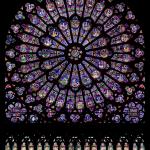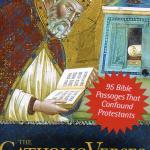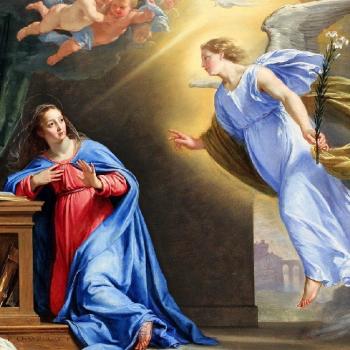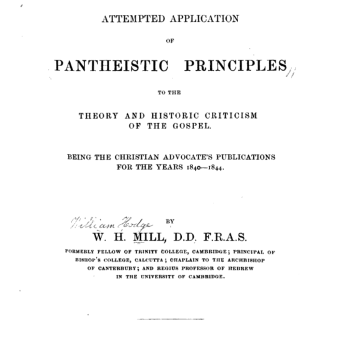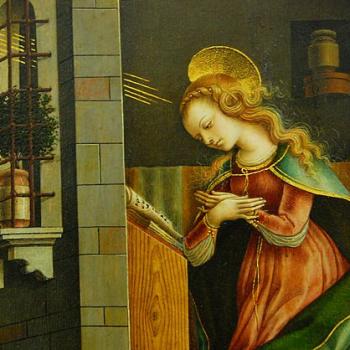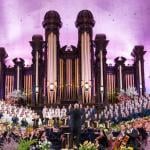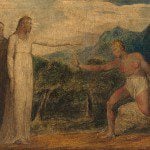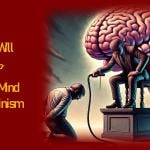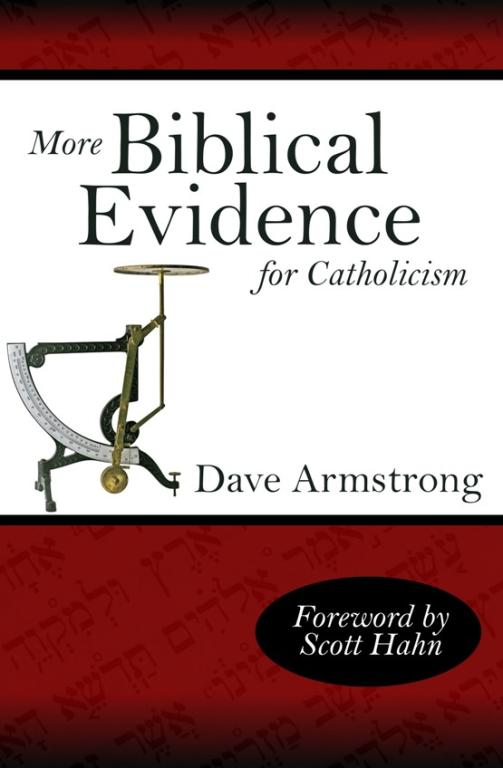
(12-11-04)
***
This is a counter-reply to a response to my best-selling pamphlet for Our Sunday Visitor, Top Ten Questions Catholics Are Asked, by Church of Christ preacher Kevin Cauley. His words will be in blue. Words from my pamphlet will be in green.
***
Complete Five-Part Series:
Part I: Introduction and Church of Christ Information
Part II: Tradition / Papacy
Part III: “Father” / Purgatory / Statues / Confession
Part IV: Mary / Eucharist
Part V: Salvation (+ Purgatory Again)
***
II. “Why do you worship Mary?”
1. Catholicism says,
1) “Catholics do not worship Mary. We venerate her because she is the mother of God the Son, our Lord Jesus Christ.”
2) “Catholics believe that Mary is the highest of God’s creatures because of her exalted role.”
3) “We believe that God saved her by taking away all stain of original sin at the moment of her conception (the Immaculate Conception).”
2. The Bible says,
1) We ought not to worship anyone but God.
a. Revelation 22:8, 9 says, “And I John saw these things, and heard them. And when I had heard and seen, I fell down to worship before the feet of the angel which shewed me these things. Then saith he unto me, See thou do it not: for I am thy fellowservant, and of thy brethren the prophets, and of them which keep the sayings of this book: worship God.”
I guess that would be why we don’t worship Mary!
b. Only God’s name is revered. Psalm 111:9 “holy and reverend is his name.”
The Hebrew word here for reverend is yare (Strong’s word #3372). In the KJV it is translated “fear” 242 times, “be afraid” 76, “terrible” 24, “reverence” twice. It is usually applied to God, but not always. In Leviticus 19:3, for example, the same word is applied to one’s parents. In Joshua 4:14 it is applied to Joshua and Moses:
On that day the LORD exalted Joshua in the sight of all Israel; and they stood in awe of him; as they had stood in awe of Moses, all the days of his life. (RSV; KJV: “fear”; cf. Joshua 3:7)
The same word is applied to the sanctuary (Lev 19:30) and an oath (1 Sam 14:26). Also, the Hebrew word for exalted here (“magnified” in the KJV) is gadal. Here it is applied to Joshua. In 1 Chronicles 29:25 and 2 Chronicles 1:1 it is a description of Solomon. Yet in Psalms 34:3 and 69:30 it is applied to God.
c. Veneration is just another name for worship. It comes from the Latin word VENEROR which means to adore, reverence, worship, revere.
d. So this is merely a smoke and mirror explanation.
This is sheer nonsense. Mr. Cauley clearly has no clue what he is talking about here. Catholic theology differentiates between the notions of dulia and latria; the second being adoration or divine worship. Are these terms biblical? Absolutely!: The Oxford Dictionary of the Christian Church (2nd ed., edited by F. L. Cross & E. A. Livingstone, Oxford Univ. Press, 1983, 430, “Dulia”), states:
(Latinized form of Greek douleia, ‘service’). The reverence which, according to Orthodox and RC theology, may be paid to the saints, as contrasted with hyperdulia, which may be paid only to the Blessed Virgin Mary, and latria (Gk., latreia), which is reserved for God alone.
This is consistent with the Catholic understanding. This dictionary goes on to define latria as follows (p. 803):
As contrasted with dulia, that fullness of Divine worship which may be paid to God alone.
Douleia can also be located in Vine’s Expository Dictionary of New Testament Words, in volume 1, p. 139, under “Bondage,” and latreia in volume 3, p. 349, under “Service, Serving.” Douleia is Strong’s word #1397. It appears five times in the NT, and is translated “bondage” in the KJV (Rom 8:15,21; Gal 4:24, 5:1; Heb 2:15: none referring to God). Latreia is Strong’s word #2999. It appears 5 times in the NT, and is translated “service” or “divine service” in the KJV – in reference to God (Jn 16:2; Rom 9:4, 12:1; Heb 9:1,6). It appears 21 times in the NT. So, as usual, so-called exclusively “Catholic” words are found to have a completely biblical basis, and to follow the distinction even present in the pre-biblical Greek etymology, since the Latin dulia and latria are directly derived from the Greek. As for the notion of veneration in general, I wrote in my book, A Biblical Defense of Catholicism (pp. 103-104):
We honor the saints in heaven, who have more perfectly attained God’s likeness (2 Corinthians 3:18), strive to imitate them, and ask them for their efficacious prayers on our behalf and that of others. All honor ultimately goes back to God, whose graces are the source of all that is worthy of veneration in the saints . . . it is God Himself Whom we praise when we celebrate in music, painting, and poetry His flowers, stars, sunsets, bald eagles, forests, mountains, or oceans. It is the painter who receives the accolades when his masterpiece is praised; likewise God with His creation, including the saints.
. . . We address judges as “Your Honor” and are commanded by God to “honor” our mothers and fathers (Ephesians 6:2), widows (1 Timothy 5:3), Christian teachers (1 Timothy 5:17), wives (1 Peter 3:7), fellow Christians (1 Corinthians 12:12-26), and governing authorities (Romans 13:7, 1 Peter 2:17). A spirit of honoring those who are worthy of honor is to typify the Christian (Romans 12:10, 1 Peter 2:17).
. . . A sound biblical basis for the veneration of saints can be found in the Pauline passages where the Apostle exhorts his followers to “imitate” him (1 Corinthians 4:16, Philippians 3:17, 2 Thessalonians 3:7-9) as he, in turn, imitates Christ (1 Corinthians 11:1, 1 Thessalonians 1:6). Also, we are exhorted to honor and imitate the “heroes of the faith” in Hebrews 6:12 and chapter 11, and to take heart in the examples of the prophets and Job, who endured suffering (James 5:10-11).
2) Mary is no more higher creation than any man in general.
a. Psalm 8:5, 6 “For thou hast made him a little lower than the angels, and hast crowned him with glory and honour. Thou madest him to have dominion over the works of thy hands; thou hast put all things under his feet:”
On the contrary, Mary was “full of grace” (Luke 1:28). She is a creature, but the very greatest one; the Theotokos (“God-bearer” / Mother of God). Because of this exalted honor, God preserved her from all stain of original sin, and she chose to never sin, her entire life. Thus, she was the “New Eve”: the second Eve who (unlike the first one) chose to never sin. The Fall of Man was not inevitable. It could have been otherwise. I wrote in my book (p. 177) about this passage:
Whichever translation one prefers (this is not necessarily an either/or proposition), it is certain that kecharitomene [RSV: “favored one”; KJV: “highly favoured”] is directly concerned with the idea of “grace,” since, as Vine noted, it is derived from the root word charis, whose literal meaning is “grace.” Charis is translated by the King James Version, for example, 129 times (out of 150 total appearances) as “grace.”
Likewise, Word Pictures in the New Testament, by the renowned Protestant [Baptist] Greek scholar A.T. Robertson, expounds Luke 1:28 as follows [Vol. 2, 13]:
“Highly favoured” (kecharitomene). Perfect passive participle of charitoo and means endowed with grace (charis), enriched with grace as in Ephesians. 1:6, . . . The Vulgate gratiae plena “is right, if it means ‘full of grace which thou hast received’; wrong, if it means ‘full of grace which thou hast to bestow’” (Plummer).
b. She was blessed. Luke 1:42 “And she spake out with a loud voice, and said, Blessed art thou among women, and blessed is the fruit of thy womb.” But many people were blessed by the Lord in the Bible.
Amen! Sure, many were blessed, but who else speaks in these terms: “henceforth all generations will call me blessed” (Luke 1:48)?
3) There is no indication in scripture that God specially took away Mary’s sins at the moment of her conception.
Luke 1:28 is the clearest indication. I’ve argued this point in many papers.
a. First, the doctrine of inherited sin is false.
a) Sin can only be committed by those who practice lawlessness. 1 John 2:4 “Every one that doeth sin doeth also lawlessness; and sin is lawlessness.”
b) Rom.5:12 “Wherefore, as by one man sin entered into the world, and death by sin; and so death passed upon all men, for that all have sinned:”
c) Sin doesn’t come from without, it comes from the heart. Matthew 15:19 “For out of the heart proceed evil thoughts, murders, adulteries, fornications, thefts, false witness, blasphemies:”
b. Second, the doctrine of the Immaculate Conception is only in place because of the doctrine of original sin.
c. One of the problems with the doctrine that sin is inherited is that Jesus would have had to inherit it.
d. The “Immaculate Conception” is the way Catholicism tries to get around the implications of this doctrine.
Mr. Cauley even preached a whole sermon about this crucial doctrine: The Argument Against the Doctrine of Original Sin, where he made such statements as the following:
There is no greater threat to practicing true Christianity than the doctrine of original sin (also known as the doctrine of total hereditary depravity).
[This is inaccurate, because not all Nicene, orthodox Christians accept total depravity. That is a Calvinist doctrine, which amounts to a more profound fall than can be warranted from scripture. Catholics, Orthodox, and Arminians hold to a less total fall — and Orthodox differ with Catholic doctrine considerably]
. . . the doctrine of original sin lies at the heart of almost every false doctrine in the “Christian” religious world today. The Bible does NOT teach this false doctrine. Reason will not support this false doctrine.
This is heterodox doctrine, according to virtually all Protestant, Catholic, and Orthodox communions. Original sin is a very important Christian dogma. If the church of Christ denies it, then it is a quasi-cultic group, just barely orthodox, according to the Nicene Creed and historic trinitarian Christianity in all its forms (along with a group like the Seventh-Day Adventists, which deny the reality of eternal hellfire). See my paper: The Biblical Evidence for Original Sin.
*****
III. “Why do you worship wafers?”
1. Catholicism teaches:
1) “A consecrated host or wafer at a Catholic Mass is the true Body and Blood of Christ, not merely bread; so Catholics are worshipping Jesus, not a wafer.”
2) They cite John 6:51-56 to support this teaching.
3) They also cite 1 Cor.10:16 and 11:27.
4) Finally they state, “In the last Supper passages (Mt.26:26-28; Mk 14:22-24; Lk 22:19-2), nothing suggests a metaphorical or symbolic interpretation.”
2. The Bible teaches:
1) Transubstantiation is the doctrine that during the Lord’s Supper the bread and fruit of the vine change into the literal body and blood of Jesus.
2) First, John 6:51-56 is not referring to the Lord’s supper. The context indicates this.
a. John 6:35 “And Jesus said unto them, I am the bread of life: he that cometh to me shall never hunger; and he that believeth on me shall never thirst.”
b. John 6:45 “It is written in the prophets, And they shall be all taught of God. Every man therefore that hath heard, and hath learned of the Father, cometh unto me.”
c. John 6:48, “I am that bread of life.”
Here is a bunch of context and exegesis concerning John 6 (more than enough for another sermon from Mr. Cauley), from my book, More Biblical Evidence for Catholicism (pp. 42-47):
*****
As for John 6 and Jesus repeatedly commanding the hearers to “eat my flesh and drink my blood,” it is known that such metaphors were synonymous with doing someone grievous injury, in the Jewish mind at that time (see, e.g., Job 19:22, Psalms 27:2, Ecclesiastes 4:5, Isaiah 9:20, 49:26, Micah 3:1-3, Revelation 16:6).
Therefore, it isn’t plausible to assert that Jesus was speaking metaphorically, according to the standard Protestant hermeneutic of interpreting Scripture in light of the contemporary usages and customs and idioms.
. . . When His hearers didn’t understand what He was saying, the Lord always explained it more fully (e.g., Matthew 19:24-26, John 11:11-14, 8:32-34; cf. 4:31-34, 8:21-23). But when they refused to accept some teaching, He merely repeated it with more emphasis (e.g., Matthew 9:2-7, John 8:56-58). By analogy, then, we conclude that John 6 was an instance of willful rejection (see John 6:63-65; cf. Matthew 13:10-23).
Only here in the New Testament do we see followers of Christ abandoning Him for theological reasons (John 6:66). Surely, if their exodus was due to a simple misunderstanding, Jesus would have rectified their miscomprehension. But He did no such thing. Quite the contrary; He continually repeated the same teaching, using even stronger terms (as indicated by different terms in the Greek New Testament). All of this squares with the Catholic interpretation, and is inconsistent with a symbolic exegesis.
Furthermore, Protestants often (ironically) interpret John 6:63 literally, when in fact it was intended metaphorically:
It is the spirit that gives life, the flesh is of no avail; the words that I have spoken to you are spirit and life. (RSV)
Protestants claim that this establishes the symbolic and metaphorical nature of the whole discourse. What they fail to realize is that when the words “flesh” and “spirit” are opposed to each other in the New Testament, it is always a figurative use, in the sense of sinful human nature (“flesh”) contrasted with humanity enriched by God’s grace (“spirit”).
This can be clearly seen in passages such as Matthew 26:41, Romans 7:5-6,25, 8:1-14, 1 Corinthians 5:5, 2 Corinthians 7:1, Galatians 3:3, 4:29, 5:13-26, and 1 Peter 3:18, 4:6. In other words, Jesus is saying that His words can only be received by men endowed with supernatural grace. Those who interpret them in a wooden, carnal way (equating His teaching here with a sort of gross cannibalism) are way off the mark.
. . . Many non-Catholics often argue that Jesus was not referring to the Eucharist at all in John 6. The word Eucharist comes from the Greek words eucharistia, eucharisteo, and eucharistos [Strong’s words #2168, 2169, and 2170]. Together these occur 54 times in the New Testament, so obviously Eucharist is an eminently biblical word. Its meaning is thanks, thankfulness, or thanksgiving. But how is that related to the Last Supper, or Lord’s Supper, or Communion? It’s very simple (all verses: RSV):
Matthew 26:27-28: And he took a cup, and when he had given thanks, he gave it to them, saying, “Drink of it, all of you; for this is my blood of the covenant, . . .” (cf. Mark 14:23, Luke 22:17,19)
There is a fascinating parallel between this language and that with regard to the feeding of the 4000 and 5000. Scripture records that Jesus “gave thanks” on those occasions, and then “broke” the fish and the loaves and “gave them to the disciples, and the disciples gave them to the crowds” {Matthew 15:36; cf. Mark 8:6}. Likewise, we see the same progression in the accounts of the Last Supper:
Luke 22:19: And he took bread, and when he had given thanks he broke it, and gave it to them, saying, “This is my body which is given for you. Do this in remembrance of me.” (cf. Matthew 26:26, 1 Corinthians 10:16, 11:23-24, Acts 2:42, 20:7)
So we have already established a parallel between the Last Supper and the ritual initiated by Jesus there (which is the central essence of the Mass), and the miraculous feeding of the crowds with bread and fish. In John 6, the same miracle occurs, except that this time the biblical writer records that Jesus ties the two together explicitly. First, we have the narrative concerning the feeding:
John 6:11: Jesus then took the loaves, and when he had given thanks [eucharisteo], he distributed them to those who were seated . . .
(cf. 6:23)
John 6:22 informs us that the rest of the story took place on the following day. But Jesus had a rebuke for the people who sought Him out on this occasion:
John 6:26-27: “. . . you seek me, not because you saw signs, but because you ate your fill of the loaves. Do not labor for the food which perishes, but for the food which endures to eternal life, which the Son of Man will give to you . . .”
In other words, Jesus is contrasting the utility of physical food with eucharistic, sacramental food (His own Body). He continues, getting more and more explicit as He goes along:
John 6:35: . . .” I am the bread of life; he who comes to me shall not hunger . . .” (cf. 6:33)
John 6:51: “I am the living bread which came down from heaven; if any one eats of this bread, he will live for ever; and the bread which I shall give for the life of the world is my flesh.” (cf. 6:48-50)
John continues:
John 6:52: The Jews then disputed among themselves, saying, “How can this man give us his flesh to eat?”
Does Jesus then say, “look guys, settle down; you misunderstood Me! I was just talking symbolically; don’t be so literal!” No, not at all. Rather, He reiterates His point in the strongest (and most literal) language:
John 6:53-58: . . .”unless you eat the flesh of the Son of man and drink his blood, you have no life in you; he who eats my flesh and drinks my blood has eternal life, . . . For my flesh is food indeed, and my blood is drink indeed. He who eats my flesh and drinks my blood abides in me, and I in him . . . he who eats me will live because of me. This is the bread which came down from heaven, not such as the fathers ate and died; he who eats this bread will live forever.”
When Jesus told parables, He always explained them, lest their meaning be lost on the hearers (and us readers of the Bible). Here he does no such thing, even though many of these people forsook Him as a result of His difficult teaching (6:60-61,64, 66-67). The symbolic interpretation makes no sense at all.
I think it is quite obvious that Jesus is referring to the Eucharist in John 6, for these reasons:
1) The parallelism between the miraculous mass feedings and the Last Supper.
2) The use of eucharisteo in the descriptions of both instances, in the same fashion.
3) The repeated reference in John 6 to His Body (i.e., eucharistically; sacramentally) giving eternal life to the recipients (John 6:27,33, 50-51,54,58). This is clearly not merely referring to belief, since if that were the case, explicit references to His Body and Blood would be entirely superfluous. He could have just spoken in terms of “belief” rather than eating and drinking His flesh and blood (which He did in many other instances: e.g., John 12:44-46, 14:10-12).
4) The equation of (what appeared to be) bread and His Body in both John 6 and the Last Supper (Matthew 26:26, Mark 14:22, Luke 22:19, 1 Corinthians 10:16-17, 11:23-24,27,29, John 6:33,48,50-51,53-58).
5) The equation of (what appeared to be) wine and His Blood in both John 6 and the Last Supper (Matthew 26:27-28, Mark 14:23-24, Luke 22:20, 1 Corinthians 10:16, 11:25,27, John 6:53-56).
*****
3) The fact is that the wafer does not change into literal flesh and the wine does not change into literal blood.
We are not claiming that it does. It is a miracle of change of substance, while the outward qualities remain the same. This is why one must have faith to believe this. One can’t accept it based on scientific verification (just as with the divinity of Christ, which couldn’t be proven by examining His flesh).
The fact that priests often get drunk from the consecrated wine should prove such.
They do? Often, huh? There are, no doubt, some alcoholic priests, but that is neither here nor there. The point misconstrues the nature of Catholic eucharistic belief, anyway.
4) 1 Cor. 10:16 “The cup of blessing which we bless, is it not the communion of the blood of Christ? The bread which we break, is it not the communion of the body of Christ?” But notice verses 17, 18 “For we being many are one bread, and one body: for we are all partakers of that one bread. Behold Israel after the flesh: are not they which eat of the sacrifices partakers of the altar?”
a. Would we, the church, also be the literal body of the Lord?
We are the Body of Christ in a different sense. Paul’s language in his passages concerning the Eucharist is very literal. Martin Luther thought this passage was compelling in and of itself:
Even if we had no other passage than this we could sufficiently strengthen all consciences and sufficiently overcome all adversaries . . . He could not have spoken more clearly and strongly . . . (Against the Heavenly Prophets in the Matter of Images and Sacraments, 1525; Luther’s Works, Vol. 40, 177, 181)
. . . The bread which is broken or distributed piece by piece is the participation in the body of Christ. It is, it is, it is, he says, the participation in the body of Christ. Wherein does the participation in the body of Christ consist? It cannot be anything else than that as each takes a part of the broken bread he takes therewith the body of Christ . . . (Ibid., LW, Vol. 40, 178)
b. The example of the Israelites who offered sacrifice, did they literally eat the altar?
No; they ate the “Lamb of God” during Passover. Jesus was the Passover Lamb. He is the sacrifice that was prefigured by the Jewish system of sacrifice.
5) 1 Cor. 11:27 says, “Wherefore whosoever shall eat this bread, and drink this cup of the Lord, unworthily, shall be guilty of the body and blood of the Lord.”
a. They suggest that if we sin against a symbol that is not being guilty of the body and blood of the Lord.
b. But note the example of Nadab and Abihu (Leviticus 10:1ff); also note Uzzah (2 Sam.6:1ff). They sinned against symbols and God took it very personally. Were they guilty of sinning against God, or of against mere symbols?
This is wrongheaded. The argument was not that it is never wrong to sin against a symbol, but rather, that doing so is not the same as being “guilty of the body and blood of the Lord.” It is the literalness which is so striking. In the Old Testament, they didn’t believe in the Incarnation, as Christians do. For the Jews, then and now, God is a spirit, and has no body. So these analogies don’t hold any water. Luther was very insistent about this passage also:
It is not sound reasoning arbitrarily to associate the sin which St. Paul attributes to eating with remembrance of Christ, of which Paul does not speak. For he does not say, “Who unworthily holds the Lord in remembrance,” but “Who unworthily eats and drinks.” (Ibid., LW, 40, 183-184)
6) In Matthew 26:26-29 we read: “And as they were eating, Jesus took bread, and blessed it, and brake it, and gave it to the disciples, and said, Take, eat; this is my body. And he took the cup, and gave thanks, and gave it to them, saying, Drink ye all of it; For this is my blood of the new testament, which is shed for many for the remission of sins. But I say unto you, I will not drink henceforth of this fruit of the vine, until that day when I drink it new with you in my Father’s kingdom.”
a. Note: If everything here is literal, then the disciples MUST drink the cup itself.
No; that would only hold by a ridiculous, impossible understanding of how English grammar works. A “literal” reading would have the blood being the transformation of the wine in the cup, not the wine plus the cup. If someone offers us some lemonade in a cup on a blazing hot day, as we’re out working in the yard, and says, “here, drink this,” do we assume that he is referring to drinking the cup as well as the lemonade (the latter of which is quite literal, and not metaphorical, as is the cup)? Of course not.
But that doesn’t stop Mr. Cauley from making himself look downright ludicrous when he desperately tries to explain away a Catholic prooftext. “Reasoning” like this only shows the heights and lengths of absurdity that folks supposedly so “biblical” will go, in order to reinterpret a passage so that it won’t read “Catholic” at all. I dealt with dozens of such instances by Protestant exegetes (but none, I confess, as silly as this particular “exegesis” of Matthew 26) in my latest book, The Catholic Verses: 95 Bible Passages That Confound Protestants.
b. If everything here is literal, then Jesus said that the cup was just fruit of the vine. But he had already blessed it. He should have said, “Blood.” Jesus, therefore, didn’t know the doctrine of Transubstantiation.
When all the relevant passages are considered together in a coherent fashion, and without preconceived notions, I think the case for Catholic belief here is very strong indeed.
***


